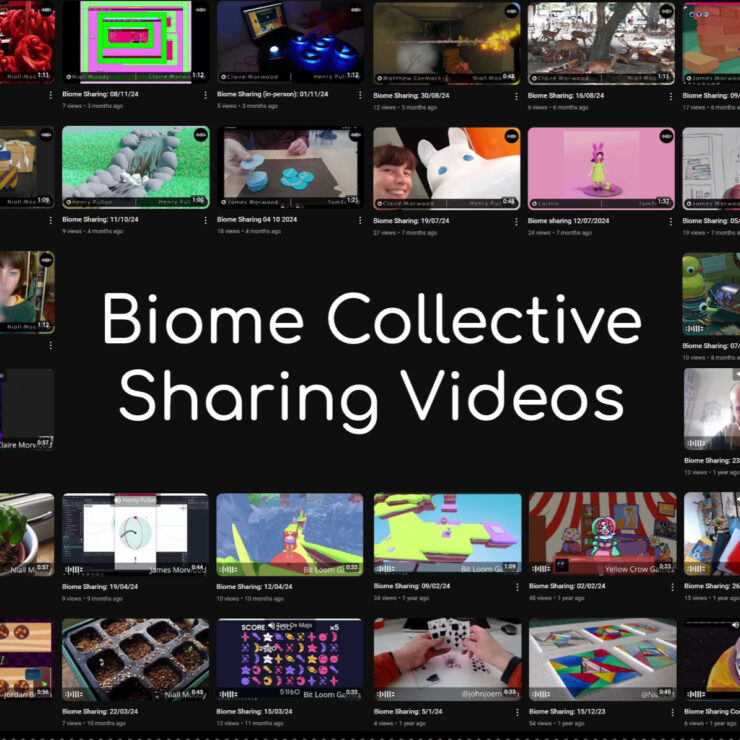Diana Grigorescu talks about Bursting At The Seams

NEoN is supporting this year’s 16 days of Activism campaign by presenting work and creative practices that use digital tools or comment on today’s complex digital relationships. In particular, we are interested in work that highlights how our digital entanglement, digital coding and the online spaces we create can reflect just about every social topic, such as freedom, compliance, censorship, gender, and everyday hostilities.
We have invited six activists to contribute to this campaign by writing an article about their stories, their jobs or their own campaigns.
////////////////////////////
Content warning – This article contains mentions of Gender Based Violence, graphic content, harassment, misogyny, discrimination, sexual abuse and everyday sexism.
I’m a Romanian artist who’s been living in Scotland for 4 years now. My professional focus is on illustration, graphic design, and concept art, but I also love pottery, wax-sealed letters, and embroidery. It’s always good to enrich and inform my practice outside of what I principally do.
I made a zine! I called it Bursting At The Seams. Inspired by my personal experiences with harassment, it’s about gender norms, perceived ugliness, misogyny, refusal to perform femininity, and their impact on mental health. I was inspired by many things: Barbara Kruger, Judy Chicago and Exotic Cancer (pseudonym), Viktor Lyapkalo’s depictions of feminine bodies, and Savanna Judd’s subversive studies of colour and light, the resulting ethereal atmosphere. The monstrous feminine (inspired by Rene Lalique’s woman-insect jewellery), fat bodies, hairy bodies, and the unacceptable metamorphosis of the ageing body reveal that femininity is a commodity: women’s bodies become fashion trends, constrained by ever-changing notions of beauty—beauty that can be achieved, enhanced, or corrected through consumption.

I was particularly inspired by horror movies, which allow characters to break social norms and entrance audiences with their grotesqueness. Here, women subvert gender norms on purpose—in the form of werewolves, for example. ”The werewolf represents traits that are accepted as masculine – strength, large size, violence, hirsutism – […] The female werewolf is disturbing because she entirely breaks the rules of femininity.” One must control every emotion out of fear of being branded hysterical. John Berger wrote that women have to scrutinise every action because how she appears to men is of crucial importance for what is normally thought of as the success of her life. We strive to be palatable, not to one’s self but to others. In reality, subverting gender norms is often dangerous: Vivek Shraya talks about her experiences with harassment for being ‘too feminine as a boy and not feminine enough as a girl and the trauma of never fitting in. The pressure to be feminine is also present for fat women, as inaction to compensate for one’s fatness is a refusal to subscribe to gender and cultural norms.
As I explored these topics, I stumbled upon the zine culture of the 1990s. Fiercely feminist and unapologetic, what started as female punk musicians fighting back against misogyny became a worldwide phenomenon of underground, self-published, photocopied and stapled booklets of activism! I decided to combine this with the recent trend of web weaving (collages of quotes, photos, gifs, screenshots, etc., that create connections between unrelated pieces of media), and to illustrate all the great fragments I was finding. I wanted my zine to be a loud scream of despair and anger, feeling dismissed and belittled. All these emotions morphed in my mind as repulsive imagery, like viscera, rabid dog mouths, and bruises, all in bright, hypersaturated colours. Gore pop. Macabre in bubblegum pink.
But as I was working, I realised that I wanted my zine to have an ending. Otherwise, it felt like letting ‘them’ win. So I explored my apathy and numbness, how I stumbled into healing and finally, the acceptance I cultivated for myself. Ultimately, this was an incredibly personal project, like a visual diary with the help of others’ words. It helped me understand my experiences better and brought catharsis. I can only hope it does the same for others or at least becomes a little memento that they’re not alone.

Since graduating from Abertay University with a BA in Computer Arts and completing an internship, I’m now a full-time Graphic Designer at Cubicle 7 Games. I get to work on tabletop roleplaying games! I’ve designed graphical elements and layouts for games such as Dungeons & Dragons, Doctor Who, Warhammer, and more. Every book is its own challenging puzzle, and every day brings something new. Thankfully I’m surrounded by a supportive team of creative-minded individuals who push me to try new techniques and grow as an artist and designer.
Image Credit: Images from the zine Bursting At The Seams by Diana Grigorescu.
NOTES:
16 Days is an international campaign to challenge violence against women and girls. The campaign runs every year from 25 November, the International Day for the Elimination of Violence against Women, to 10 December, Human Rights Day. This year’s theme is 16 Days of Activism. The Global 16 Days Campaign, launched by the Center for Women’s Global Leadership (CWGL) and feminists from around the world at the first Women’s Global Leadership Institute in 1991, has been used worldwide to call for the elimination of gender-based violence (GBV).
Services available to women in Dundee:
Violence Against Women Services for Vulnerable Women Booklet 2022
Gender-Based violence refers to harmful acts directed at an individual based on their gender. It is rooted in gender inequality, power abuse, and harmful norms.
Gender-based violence (GBV) is a serious violation of human rights and a life-threatening health and protection issue. It is estimated that one in three women will experience sexual or physical violence in their lifetime. During displacement and times of crisis, the threat of GBV significantly increases for women and girls.


